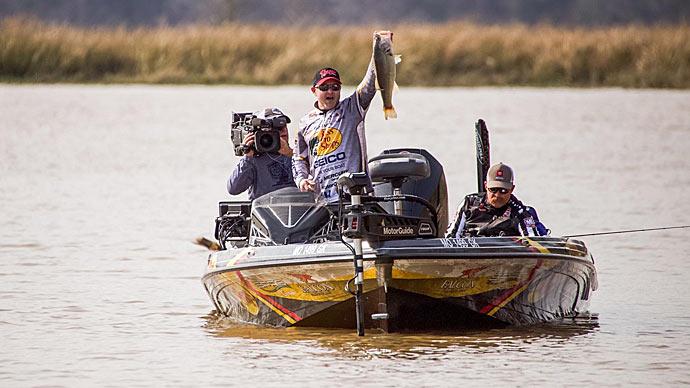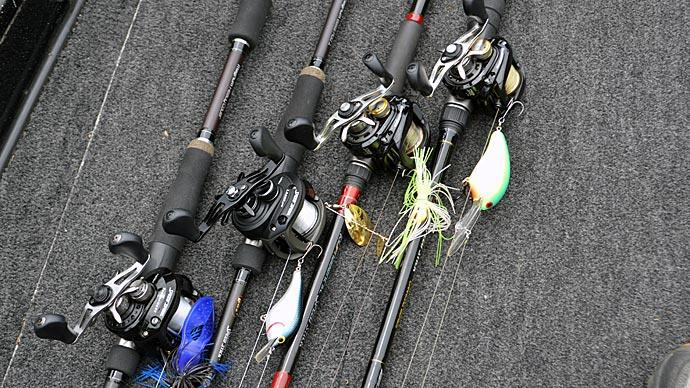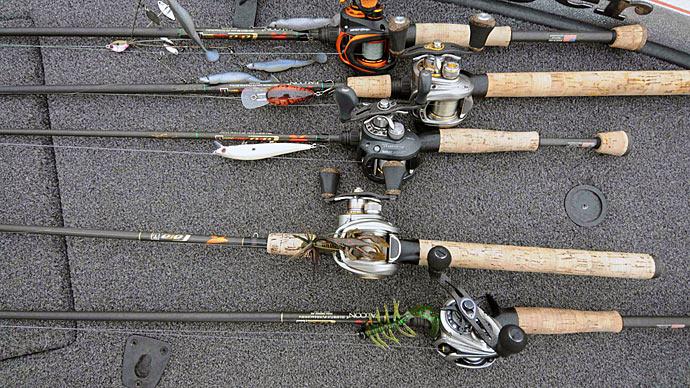
When discussing the construction of rods or buying a rod, there are several terms used, primarily "action" and "power." Many folks assume these terms to be interchangeable, but they are not. Instead, they each describe unique characteristics that affect rod performance, how the bait is presented, and ultimately how, or if, you catch fish.
Let's get one thing straight: Not understanding the difference between action and power will not prevent you from catching fish. However, knowing the differences and how they affect your application and presentation will make you better and land you more fish. It's like the saying, "when all you have is a hammer in your toolbox, everything is a nail." You can catch fish with a broom handle and twine, but this will limit your options and opportunities. If you read this article, in the end, you will understand why.
Action:
Action refers to the "movement" of the blank. How and where the blank flexes dictate the action. A "fast" blank will flex in the upper one-third of the blank, while a slow "softer" blank will be more parabolic and flex almost over the upper three-fourths of its length.
Think of action as how "fast" it takes for the blank to return to "rest" after being put under load. A fast blank will not flex very far from its resting state. Once the load is released, it will not take long for the blank to return. Conversely, a "slow" blank will flex in the top three-fourths of the blank. The range of motion will be much more significant, and it will take longer for the blank to return to the at-rest state. Thus, the term "slow" is used to describe this characteristic.
Extra fast, fast, moderate, and slow actions refer to flex and, ultimately, the relative time it takes for the rod to return to the at-rest position once released from under a load. By knowing and understanding the action of a blank, you can utilize that blank's properties to enhance a particular technique.
Power:
Now that action is understood to describe how a blank flexes, let's look at the blank's resistance to flexing. The resistance to flexing is called Power. Power refers to the blank's resistance to flexing under load. Remember Newton's third law: For every action, there is an equal and opposite reaction.
Resistance to flexing (Power) is an inherent design characteristic based on the taper and wall thickness of the blank. The power for blanks may range from Ultra-Light to Heavy to even Extra Heavy - the broom handle previously discussed.
As you can see, Action and Power are different and cannot be used interchangeably as some think.
One other note about Action and Power that further complicates the discussion and understanding is that there are no industry standards used by rod and blank manufacturers to describe Action and Power. You go to a car lot and see a car that gets twenty miles per gallon and goes from zero to sixty miles per hour in twelve seconds. You can then look at another car on the lot and see the car gets twelve miles per gallon and goes from zero to sixty in seven seconds. Right away, you can make some distinctions and know what to expect and how it should (or should not) be used when you purchase based upon known, recognized industry standards.
Fishing rods do not have this "standard." A fast action, medium power St. Croix blank may and probably will have different action and power characteristics compared to a fast action, medium power G. Loomis or Lamiglas blank.
At this point, you are probably thinking, "OK, I get it. Action refers to rod flex, and Power refers to the rod's resistance to flexing. But how does all this techno-jargon help me catch fish?"
Using a blank's design criteria and inherent characteristics will aid in specific techniques and presentations. Using blank characteristics to your advantage will provide you the benefit of making the most out of every opportunity to land fish. So, let's add more tools to that toolbox in addition to the hammer.
The discussion around technique application will center on Action as opposed to Power. The manufacturer designed both traits into the blank, but action will be the most critical characteristic when discussing and evaluating techniques and presentations.
Extra-Fast:
The primary benefits of an Extra-Fast blank are its sensitivity and the quick response to bringing the inherent power of the blank into play when fighting the fish. In addition, the Extra-Fast blank will be stiffer, transmitting vibration to your hand much more efficiently than a slow/soft blank.
The Extra-Fast blank is a prime consideration for single hook applications where sensitivity is needed to detect the smallest nibbles and then immediate power to set the hook. Primary techniques for these blanks are worm and jig presentations, spinnerbait, and some swimbaits.
With everything, there are tradeoffs.
Although the Extra-Fast blank provides exceptional sensitivity and efficient access to the power of the blank, the Extra-Fast tip works against you somewhat while fighting the fish. Because the Extra-Fast blank returns to the at-rest position very quickly, the Extra-Fast tip makes it very difficult to maintain proper tension to keep the lure secure.
As the hooked fish surges and lunges to get loose, maintaining too much tension with a stiff blank could cause the hook to tear a hole in the fish's mouth or make the hole larger, allowing the fish to throw the bait. Too little tension will also help contribute to the fish throwing the lure. When the fish lunges against a loose line, the line suddenly tightens. The force of the lunge, in conjunction with the rod's power, could cause the hook to pull portions of the mouth, lips, or muscles off the fish. Not only could you miss the fish of a lifetime, but worse yet, the fish may be permanently injured.
Fast:
The Fast action blank maintains most of the sensitivity found in the Extra-Fast blank, but given that it is a "Fast" action, it has more flex. After the hookup, the more flexible tip will provide better fish-fighting capability. In addition, the tip, and the blank, can absorb more of the shock as the fish surges and lunges and will maintain better tension on the line.
Good applications for fast action rods are techniques where sensitivity is just as important as fighting ability. For example, a primary application for Fast action rods is throwing single hook rigs through and over loose weeds and grass. A more limber, flexible rod would have difficulty generating the power to jerk the lure free from weeds and grass.
Presentations and techniques that benefit from Fast action rods are jigs, Texas rigged, and Carolina rigged worms.
Moderate to Slow:
The Moderate to Slow action blanks are usually suitable for multi-hook (treble) lures such as crankbaits, rattle baits, and jerk baits. These fast-moving fish-finding baits work best with a soft tip action and the ability to throw the lure over long distances.
These lures and presentations typically require less sensitivity and focus more on keeping the fish hooked. The wire diameter of the treble hook is typically thinner than a single hook and requires less pressure to set the hook. In addition, given that there are more hooks, there are more opportunities for a good hook set.
The Slow tip will cause the blank to return to the at-rest position much more slowly than faster action blanks. Proper tension is much easier to maintain with this characteristic, keeping the hook engaged while the fish surges and lunges. In addition, the rod is much more adept at reacting to the fish's abrupt actions.
I remember fishing from the shore one time. I was getting ready to pull my rattletrap from the water when I saw a three-pound Largemouth Bass come darting in, take the bait, and swim rapidly away. It happened in the time it probably took you to read this sentence. I didn't have time to react, release the spool, drop pressure, set the hook, etc. So instead, the slow action of the rod allowed the fish to inhale the bait, turn, swim away, and set the hook itself while I stood there watching in amazement.
I had not fought it while bringing it to shore, so the fish was ready for a fight! With only a few feet of line out, I had to rely on rod flex to maintain a good hookup, yet give and bend with every lunge, surge and jump the fish made.
Ok, I am starting to get into fish stories now, so let me close this discussion. This has been a very high-level overview of rod action and power. It is meant to cover the basics and how the two characteristics benefit and impact each other for various techniques. You can use this information to equip yourself better when on the water AND when choosing a new rod.
See you on the water,
Eddie
Eddie Taylor is the owner of WeaverCraft Custom Fishing Tackle. If you have any questions or comments, please do not hesitate to contact him at eddie@weavercraftfishing.com.




